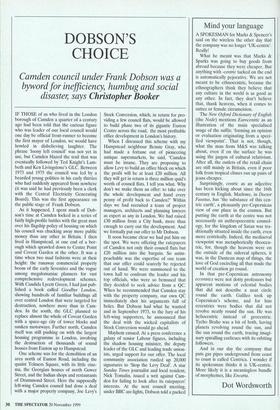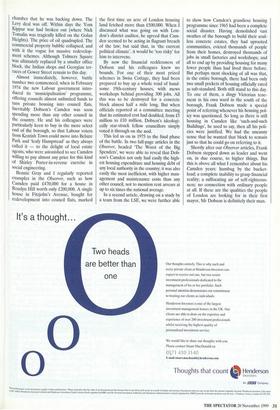DOBSON'S CHOICE
Camden council under Frank Dobson was a byword for inefficiency, humbug and social disaster, says Christopher Booker
IF THOSE of us who lived in the London borough of Camden a quarter of a century ago had been told that the curious figure who was leader of our local council would one day be official front-runner to become the first mayor of London, we would have howled in disbelieving laughter. The phrase 'loony left council' was not yet in use, but Camden blazed the trail that was eventually followed by Ted Knight's Lam- . beth and Ken Livingstone's GLC. Between 1973 and 1975 the council was led by a bearded young politico in his early thirties who had suddenly appeared from nowhere (it was said he had previously been a clerk with the Central Electricity Generating Board). This was the first appearance on the public stage of Frank Dobson.
As it happened, I spent much of Dob- son's time at Camden locked in a series of fairly high-profile battles with the great man over his flagship policy of housing on which his council was chucking away more public money than any other in Britain. I then lived in Hampstead, at one end of a bor- ough which sprawled down to Centre Point and Covent Garden at the other. It was a time when two mad fashions were at their height: the runaway commercial property boom of the early Seventies and the vogue among megalomaniac planners for vast comprehensive redevelopment schemes. With Candida Lycett Green, I had just pub- lished a book called Goodbye London, showing hundreds of familiar buildings all over central London that were targeted for destruction, nowhere more than in Cam- den. In the south, the GLC planned to replace almost the whole of Covent Garden with a space-age city of tower blocks and sunken motorways. Further north, Camden itself was still pushing on with the largest housing programme in London, involving the destruction of thousands of sound houses from Euston up to Hampstead.
One scheme was for the demolition of an area north of Euston Road, including the quaint Tolmers Square, with its little cine- ma, the Georgian houses of north Gower Street, and the Indian shops and restaurants of Drummond Street. Here the supposedly left-wing Camden council had done a deal with a major property company, Joe Levy's Stock Conversion, which, in return for pro- viding a few council flats, would be allowed to build phase two of its gigantic Euston Centre across the road, the most profitable office development in London's history.
When I discussed this scheme with my Hampstead neighbour Bennie Gray, who had made a fortune out of pioneering antique supermarkets, he said, 'Camden must be insane. They are proposing to allow Levy to build an office block on which the profit will be at least £20 million. All they will get in return is three million quid's worth of council flats. I tell you what. Why don't we make them an offer: to take over the whole development and hand every penny of profit back to Camden?' Within days we had recruited a team of project managers, architects and planning lawyers as expert as any in London. We had raised £30 million from a City bank, more than enough to carry out the development. And we formally put our offer to Mr Dobson.
It soon became clear we had put him on the spot. We were offering the ratepayers of Camden not only their council flats but £20 million into the bargain. So unim- peachable was the expertise of our team that our offer could scarcely be rejected out of hand. We were summoned to the town hall to confront the leader and his top officials, who were so bemused that they decided to seek advice from a QC. When he recommended that Camden stay with the property company, our own QC immediately shot his arguments full of holes. But Dobson had what he wanted and in September 1973, to the fury of his left-wing supporters, he announced that the deal with the wicked capitalists of Stock Conversion would go ahead.
Mayhem ensued. At a press conference a galaxy of senior Labour figures, including the shadow housing minister, the deputy leader of the GLC and leading trade union- ists, urged support for our offer. The local community association rustled up 20,000 signatures to 'Stop the Levy Deal'. A star Sunday Times journalist and local resident, Nick Tomalin, issued a writ against Cam- den for failing to look after its ratepayers' interests. At the next council meeting, under BBC arc-lights, Dobson told a packed
chamber that he was backing down. The Levy deal was off. Within days the Yom Kippur war had broken out (where Nick Tomalin was tragically killed on the Golan Heights). The price of oil quadrupled. The commercial property bubble collapsed, and with it the vogue for massive redevelop- ment schemes. Although Tolmers Square was ultimately replaced by a smaller office block, the Indian shops and Georgian ter- races of Gower Street remain to this day.
Almost immediately, however, battle number two commenced, when in February 1974 the new Labour government intro- duced its 'municipalisation' programme, offering councils almost unlimited funds to turn private housing into council flats. Inevitably Dobson's Camden was soon spending more than any other council in the country. He and his colleagues were Particularly keen to buy in the more select end of the borough, so that Labour voters from Kentish Town could move into Belsize Park and 'leafy Hampstead' as they always called it — to the delight of local estate agents, who were astonished to see Camden willing to pay almost any price for this kind of Shirley Porter-in-reverse exercise in social engineering.
Bennie Gray and I regularly reported examples in the Observer, such as how Camden paid £470,000 for a house in Rosslyn Hill worth only £200,000. A single house in Fitzjohn's Avenue, bought for redevelopment into council flats, marked
the first time an acre of London housing land fetched more than £500,000. When I discussed what was going on with Lon- don's district auditor, he agreed that Cam- den seemed to be acting in flagrant breach of the law; but said that, in 'the current political climate', it would be 'too risky' for him to intervene.
By now the financial recklessness of Dobson and his colleagues knew no bounds. For one of their most prized schemes in Swiss Cottage, they had been prepared to buy up a whole road of hand- some 19th-century houses, with mews workshops behind providing 300 jobs. All this was to be destroyed for a concrete block almost half a mile long. But when officials reported at a committee meeting that its estimated cost had doubled, from £5 million to £10 million, Dobson's ideologi- cally star-struck fellow councillors simply voted it through on the nod.
This led us on in 1975 to the final phase of the battle. In two full-page articles in the Observer, headed 'The Worst of the Big Spenders', we were able to reveal that Dob- son's Camden not only had easily the high- est housing expenditure and housing debt of any local authority in the country; it was also easily the most inefficient, with higher man- agement and maintenance costs than any other council, not to mention rent arrears at up to six times the national average.
In a second article, drawing on a study by a team from the LSE, we were further able to show how Camden's grandiose housing programme since 1965 had been a complete social disaster. Having demolished vast swathes of the borough to build their soul- less concrete estates, they had uprooted communities, evicted thousands of people from their homes, destroyed thousands of jobs in small factories and workshops; and all to end up by providing housing for many fewer people than had lived there before. But perhaps most shocking of all was that, in the entire borough, there had been only two small pockets of housing officially rated as sub-standard. Both still stand to this day. To one of them, a dingy Victorian tene- ment in his own ward in the south of the borough, Frank Dobson made a special point of referring whenever his housing pol- icy was questioned. So long as there is still housing in Camden like 'such-and-such Buildings', he used to say, then all his poli- cies were justified. We had the uncanny sense that he wanted that block to remain just so that he could go on referring to it.
Shortly after our Observer articles, Frank Dobson stepped down as leader and went on, in due course, to higher things. But this is above all what I remember about his Camden years: humbug by the bucket- load; a complete inability to grasp financial reality; a suffocating air of self-righteous- ness; no connection with ordinary people at all. If these are the qualities the people of London are looking for in their first mayor, Mr Dobson is definitely their man.



























































































 Previous page
Previous page